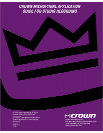
INTRODUCTION
In this guide you’ll find suggestions on using Crown
microphones to record music effectively. Whether you
run a large professional facility, or a project studio,
you’ll find useful tips here. We’ll cover some basics of
miking, Crown mic models for studio use, and
specific applications.
At Crown we’ve designed several mics specifically for
studio applications. All these mics were field-tested in
studios. Some were approved as is; others were
enhanced with suggested improvements. We know
you’ll like how they sound, and will appreciate their
value.
MICROPHONE
TECHNIQUE BASICS
How to reduce reverberation
Reverberation is sometimes loosely called “room
acoustics” or “ambience.” It is a pattern of sound
reflections off the walls, ceiling, and floor. For ex-
ample, reverberation is the sound you hear just after
you shout in an empty gymnasium. Too much rever-
beration in a recording can make the recorded
instrument sound distant or muddy. To reduce
reverberation:
• Place the mic closer to the sound source.
• Pick up electric instruments with direct boxes or
cables.
• Use a room or studio with dead acoustics. The walls,
ceiling, and floor should be covered with a sound-
absorbing material.
• Use directional microphones. Hypercardioid and
supercardioid patterns reject reverb more than
cardioid. Cardioid and bidirectional patterns reject
reverb equally well. Cardioid rejects reverb more
than the omnidirectional pattern at the same
distance:
Omnidirectional 0.0 dB
Cardioid -4.8 dB
Bidirectional -4.8 dB
Supercardioid -5.7 dB
Hypercardioid -6.0 dB
How to reduce background noise
• Stop the noise at its source: turn off appliances and
air conditioning; wait for airplanes to pass; close and
seal doors and windows; use a quiet room.
• Mike close with directional mics.
• Pick up electric instruments with direct boxes or
cables.
• Aim the null of the polar pattern at the offending
noise source. The null is the angle off-axis where the
mic is least sensitive. Different polar patterns have
nulls at different angles. Shown below are the null
angles for various polar patterns (Figure 1):
Cardioid 180 degrees
Supercardioid 125 degrees
Hypercardioid 110 degrees
Bidirectional 90 degrees
3
How to reduce leakage
Leakage (also called bleed or spill) is the overlap of
sound from one instrument into another instrument’s
microphone. For example, if you’re miking drums and
piano each with its own microphone, any drum sound
picked up by the piano mic is leakage. To reduce
leakage:
• Mike close with directional microphones.
• When recording, overdub instruments one at a time
on each track of a multitrack recorder.
• Pick up electric instruments with direct boxes or
cables.
• Use a room or studio with dead acoustics. The walls,
ceiling, and floor should be covered with sound
absorbing material.
• Aim the null of the polar pattern at the undesired
sound source. For example, suppose you’re miking
two adjacent tom-toms with two hypercardioid mics.
The null of the hypercardioid is 110 degrees off-axis.
Angle each mic so that its null aims at the adjacent
tom-tom.













